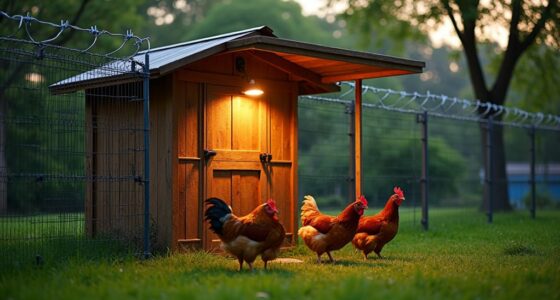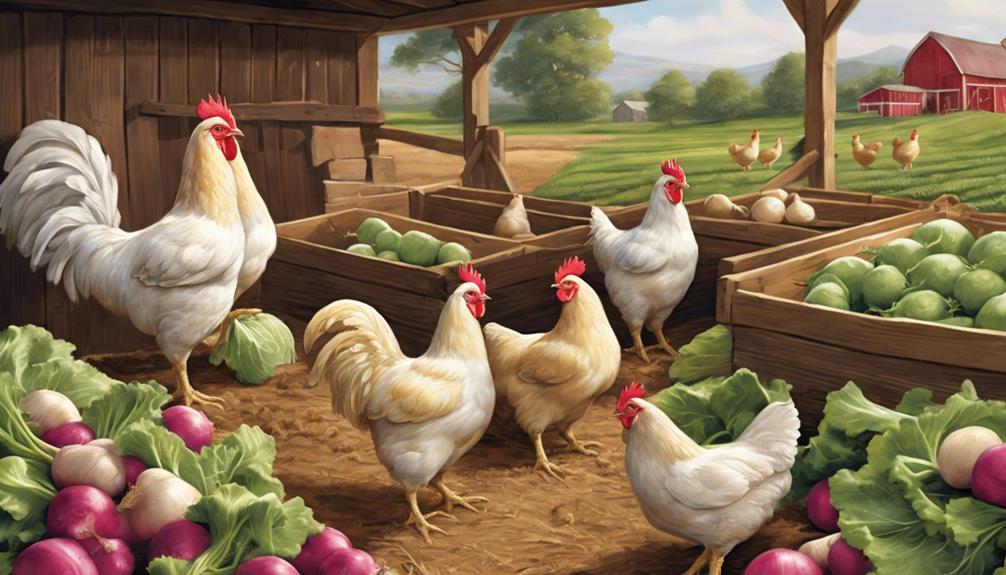Chickens are amazing feathered friends with a long history of domestication that started over 8,000 years ago in Southeast Asia. They come in many breeds, each with unique looks and talents, like the Silkie’s soft feathers or the Plymouth Rock’s versatility. Some breeds are tiny Bantams, and others are great for eggs or meat. As you explore more, you’ll discover even more fun facts about these fascinating birds!
Key Takeaways
- Chickens were first domesticated in Southeast Asia about 8,000 years ago from wild birds.
- There are many breeds of chickens, each with unique colors, feathers, and purposes like eggs or meat.
- The Silkie breed has soft, silk-like feathers and a gentle personality, making it a popular pet.
- Some chickens, called Bantams, are very small and often kept as ornamental or show birds.
- Chickens can lay hundreds of eggs each year, with breeds like Leghorn known for their large white eggs.

Have you ever wondered what makes chickens so fascinating? These lively birds have a rich history that traces back thousands of years. The history of chickens begins in Southeast Asia, where they were first domesticated around 8,000 years ago. Over time, humans selectively bred chickens for various traits, leading to the many chicken breeds we see today. Some breeds were developed for their eggs, like the Leghorn, which lays a large number of white eggs. Others, like the Rhode Island Red, were bred for their excellent meat and egg production. Different breeds have unique appearances, with some sporting bright feather colors and others with fluffy crests or distinctive combs. This diversity makes chickens even more interesting to learn about.
As you explore chicken breeds, you’ll notice that each one has special qualities. For example, the Silkie is known for its soft, silk-like feathers and calm nature, making it a popular pet. The Plymouth Rock is a friendly breed that produces both eggs and meat, making it a versatile bird. Meanwhile, the Bantam breeds are smaller versions of common chickens, often kept as ornamental pets or show birds. The variety in breeds reflects centuries of human effort to improve chickens for specific purposes, whether for farm productivity or companionship. Because of this history, chickens aren’t just farm animals; they’re a result of a long, fascinating process of domestication and breeding.
You might also find it interesting that some chicken breeds are quite ancient, dating back hundreds of years, while others are more recent creations. This history helps explain why chickens have such a wide range of appearances and behaviors. Understanding the different breeds and their origins can give you a new appreciation for these birds, whether you see them pecking around a farmyard or in a backyard coop. It’s amazing to think that what started as a wild bird has been shaped over thousands of years into so many diverse breeds, each with its own special traits. The diversity among breeds is also a testament to the selective breeding efforts of humans throughout history. Additionally, the domestication process has played a key role in shaping the characteristics of modern chickens. In fact, genetic diversity among breeds has contributed to their adaptability and resilience.
Frequently Asked Questions
Do Chickens Have a Sense of Humor?
You might wonder if chickens have a sense of humor. While they don’t laugh like humans, they do enjoy funny farm stories and playful behaviors that seem to show they appreciate chicken humor. Chickens often peck at each other or do silly things that can make you smile. So, even if they don’t get jokes, their playful antics suggest they enjoy a good laugh, or at least a good time!
Can Chickens Recognize Human Faces?
You might wonder if chickens can recognize human faces. The answer is yes; chickens have impressive chicken facial recognition and strong human recognition skills. They can remember individuals and distinguish between different people, especially those they associate with food or care. This ability helps them feel more secure around familiar faces, making it easier for you to bond with your feathered friends and earn their trust over time.
How Far Can a Chicken Run in a Day?
Imagine a chicken on a mission, racing across the farm like a tiny athlete. You might be surprised to learn that chickens can run up to 15 feet per second, covering around 2,500 feet in a day if they’re motivated. During chicken racing or exploring beyond farm fencing, they can easily run several hundred meters, showcasing their surprising stamina and agility. So, they’re more than just clucking around—they’re sprinters with a purpose.
Do Chickens Dream When They Sleep?
You might wonder if chickens dream when they sleep. While there’s no definitive proof, chicken sleep patterns suggest they enter REM sleep, which is linked to dreaming in humans. Chicken dreaming theories propose they could have similar experiences, possibly replaying daily activities. Watching chickens rest quietly, you can imagine they might dream about foraging or scratching the ground, making sleep a fascinating part of their daily life.
Can Chickens Learn Tricks Like Dogs?
Think of chickens as clever as a fox in a henhouse. Yes, you can train chickens like dogs, thanks to their surprising bird intelligence. With patience and consistent chicken training, they can learn tricks such as pecking specific targets or coming when called. Chickens respond well to positive reinforcement, proving they’re smarter than many give them credit for. So, don’t be surprised if your feathery friend learns a few tricks up their wing!
Conclusion
Now that you’ve learned these fun chicken facts, you can see your feathered friends as more than just barnyard birds—they’re like little superheroes with shiny feathers and clever minds. Next time you see a chicken, think of it as a tiny explorer on a big adventure, full of surprises. Keep observing, asking questions, and discovering all the amazing things these feathery friends have to offer. Remember, every chicken has a story waiting to be told!










